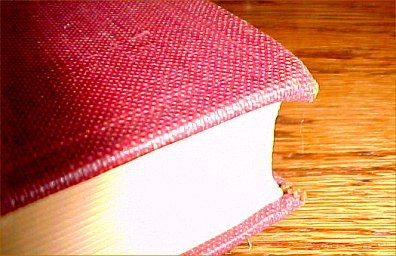|
|

|
BookThink Book Repair
by Craig Stark
#1, 1 September 2003
|
How to Repair Bumped Corners
One of the most common defects present in books is
bumped corners. There is perhaps no more vulnerable
spot on a book than its corners, and in the same way
that the laws of the universe dictate that buttered
bread will fall buttered side down, a book will
inevitably fall so as to maximize damage to its
corners. Up until now you may have accepted this
state of affairs, noted the damage in your
descriptions, and moved on, but you might be
interested to know that it's possible to repair bumped
corners using a simple technique and a few dollars
worth tools and supplies. The resulting repair will
also make a book's corners less susceptible to damage
in the future.

If you've ever examined a badly bumped corner on a book, one in which the corner is not only
deformed but the board fabric is torn so as to expose the cardboard core as well, you've probably
observed that the core has begun to delaminate into layers. When the fabric isn't torn, this
delamination is hidden from view but still present, and it's this that we need to focus our attention
on.
Two things need to be accomplished with the damaged core. First, the layers must somehow be
readily re-laminated as a unit (not individually glued), and second, in the case of a book with
intact board cloth, whatever glue is used to do this needs to be introduced to the damaged area
without cutting a conspicuous access hole into the material covering it. Seems like a tall order, especially
given that so many layers of cardboard need to be glued and accessibility through cloth,
leather or paper seems severely limited.
Well, two of the items shown in figure 2 will make our life much easier - a bottle of water soluble
glue and a syringe.
The glue can be diluted to any consistency simply by adding water,
and a syringe can be used to introduce the diluted mixture into the damaged area with minimal
disturbance of the outer material. The mixture itself will penetrate the layers of paper
almost as quickly as pure water would. Woodworkers have used this technique for decades for
delicate repairs on wood, and what are most books if not a processed form of wood?
I use a ratio of at least 2 parts water to 1 part glue.
Anything thicker, and it will be difficult to inject it through the syringe and penetration
through the layers will slow significantly. However, if the material covering the boards is
finely woven cloth, leather, or even paper, a smaller diameter needle will be necessary, and
the dilution ratio will need to be increased to 3 to 1 or even 4 to 1. At these ratios great
care must be exercised with leather covers so as to limit dampening of the leather itself.
If the book in question is valuable, it would be best to introduce only a small amount of glue,
allow it to dry, and repeat as necessary.
Figure 3 shows the glue being injected into the core.
If dampening the cover material isn't an issue, glue can be added until squeeze-out is observed,
at which time the excess glue can be wiped off with a damp rag.
A proposed clamping configuration is shown in figure 4.
Note that the wood clamping blocks have rounded edges to prevent any footprints on the cover
and that waxed paper is inserted between them and the boards to prevent sticking. Before final
clamping, it's important to squeeze out any excess glue by way of a trial (tight) clamping.
In the final clamping, care should also be exercised not to clamp too tightly but just tight
enough to return the thickness of the corner to that of the rest of the board.
Over-tightening will almost inevitably produce a flattened, expanded corner not
unlike a penny left on a railroad track - and there's no way to repair this.
Finally, since we're using significantly diluted glue, it's important to allow for ample
drying time. I recommend at least 24 hours.
Done! Once the clamps are removed you'll be pleased to observe, as shown in figure 5, a
perfectly restored corner, and since the cardboard core is now impregnated with hardened glue,
a corner that's significantly stiffer and less prone to damage than it ever was.
Obviously, boards covered with coarsely woven fabric will be the easiest to deal with, but good
results can also be achieved with any fabric, especially as you gain experience, and, if you have
patience as well, with leather and paper. Metal boards or those covered with more exotic materials
such as snakeskin (yes, it has been done) will undoubtedly present insurmountable difficulties.
In cases of exposed boards - those with torn covering material - it may be possible to repair
the material as well. This will be discussed in a future article. IMPORTANT NOTE: as in all
repairs made to books intended for resale, especially collectible books, it's the responsibility of
the seller to disclose repairs. Also, I think it's important to remember
that there are three very good reasons for repairing books that have nothing to do with making them
more presentable for resale.
All three reasons are satisfied with this repair:
1. To extend the useful life of a book.
2. To decrease the likelihood of further damage to it.
3. To restore it to a former state.
Syringes and needles for this repair may be ordered for less than $10 either online at
Woodworker's
Supply or by calling 1-800-645-9292 (24/7). Service here is both friendly and consistently
prompt, and has been for as long as we've been using them. I've had good success using archival polyvinyl acetate glue, available in several brands.
|

